商务英语论文提纲(2020年整理).pdf
- 格式:pdf
- 大小:169.36 KB
- 文档页数:4
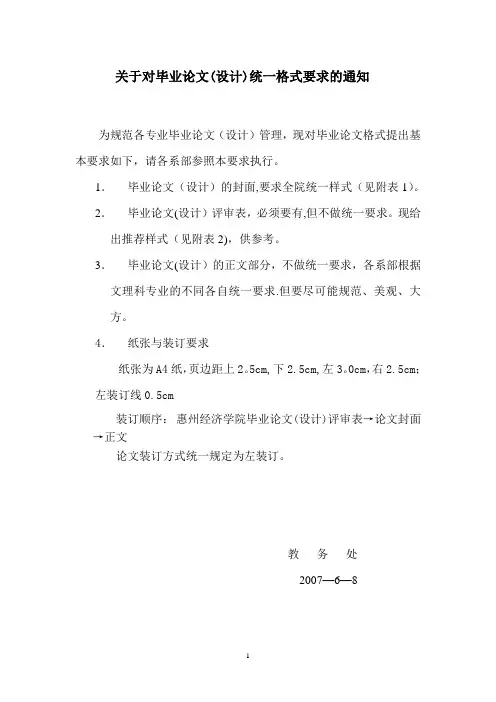
关于对毕业论文(设计)统一格式要求的通知为规范各专业毕业论文(设计)管理,现对毕业论文格式提出基本要求如下,请各系部参照本要求执行。
1.毕业论文(设计)的封面,要求全院统一样式(见附表1)。
2.毕业论文(设计)评审表,必须要有,但不做统一要求。
现给出推荐样式(见附表2),供参考。
3.毕业论文(设计)的正文部分,不做统一要求,各系部根据文理科专业的不同各自统一要求.但要尽可能规范、美观、大方。
4.纸张与装订要求纸张为A4纸,页边距上2。
5cm,下2.5cm,左3。
0cm,右2.5cm;左装订线0.5cm装订顺序:惠州经济学院毕业论文(设计)评审表→论文封面→正文论文装订方式统一规定为左装订。
教务处2007—6—8惠州经济职业技术学院毕业论文课题名称学生姓名学号专业班级指导教师二00七年六月附表2惠州经济职业技术学院毕业论文(设计)评审表文化教育大类毕业设计与论文的写作特点高职高专文化教育大类专业毕业论文在特点上,有和其他专业的毕业论文相同的共性,如前面章节中提到的理论性、创造性、指导性、专业性、层次性、规范性等,又有自己的特点。
1 针对性一般高等院校的文化教育大类专业的学习领域较为广泛,其毕业论文可分“文学”、“语言"、“翻译"、“文化”和“教学法"等5个专题,而高职高专学生的学习除精读、泛读、语法、翻译、口语、听力等必修的专业基础课程外,其余基本就是根据各院校的职业设计而确立的课程了,所以,毕业论文也应针对所学习过的课程,而不要涉及未接触过的专题,如“文学”等.这样学生写作时才便于搜集材料,有的放矢,避免一味大谈或抄袭自己都不懂的深奥领域。
2 实践性高职高专院校学生在学习理论知识过程中,其实践课程的学习也是一个重要环节。
因此,学生的毕业论文也应体现出这一特点。
文化教育大类专业的毕业论文就要将专业方向基础理论课程的学习与其实践课程结合起来进行研究活动,分析专业知识学习对其具体实践活动的作用、意义,把知识转化为能力的实际训练。
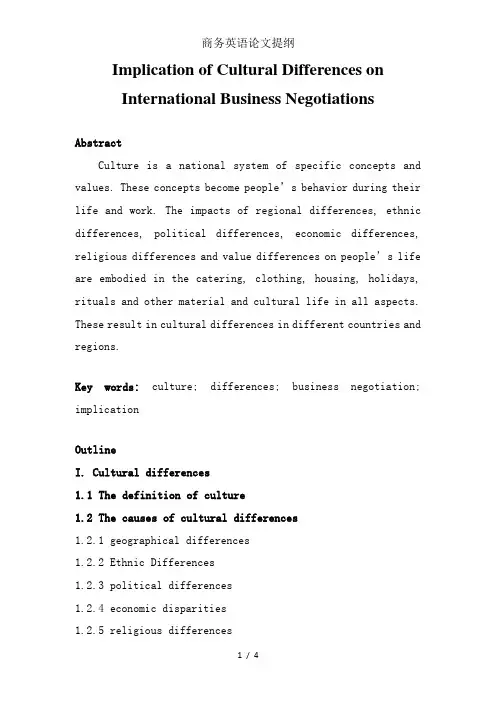
Implication of Cultural Differences onInternational Business NegotiationsAbstractCulture is a national system of specific concepts and values. These concepts become people’s behavior during their life and work. The impacts of regional differences, ethnic differences, political differences, economic differences, religious differences and value differences on people’s life are embodied in the catering, clothing, housing, holidays, rituals and other material and cultural life in all aspects. These result in cultural differences in different countries and regions.Key words: culture; differences; business negotiation; implicationOutlineI. Cultural differences1.1 The definition of culture1.2 The causes of cultural differences1.2.1 geographical differences1.2.2 Ethnic Differences1.2.3 political differences1.2.4 economic disparities1.2.5 religious differences1.2.6 the concept of Values difference1.2.7 Law and Ethics DifferencesII. Cultural differences on the impact of international business negotiations2.1 communication process2.2 Impact of Value Views Differences on International Business Negotiations2.2.1 Impact of Time View Difference on Negotiation.2.2.2 Impact of Equality View Difference on Negotiation2.2.3 Impact of Objectivity Difference on Negotiation2.2.4 Impact of Thinking Model Differences on International Business Negotiation2.2.5 Ethics2.2.6 The concept of collective2.3 Negotiating Style Differences2.4 International Thinking and Analytic Thinking2.5 Negotiation Structure2.6 Negotiation StyleIII. Conclusion文化因素对国际商务谈判的影响摘要:文化是国家系统特有的思想和价值。
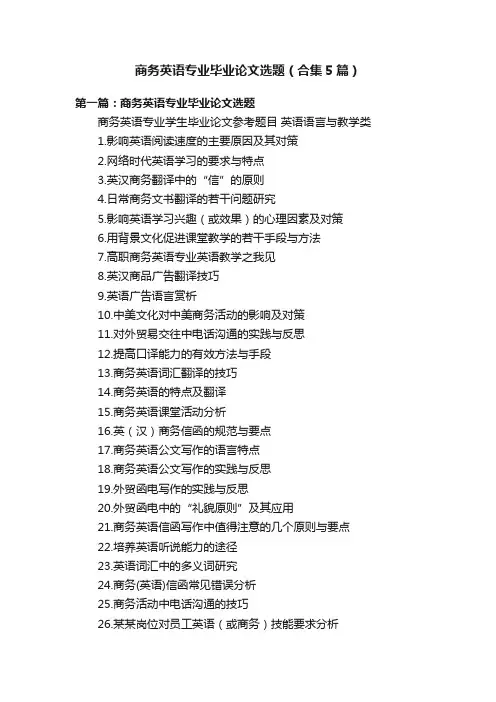
商务英语专业毕业论文选题(合集5篇)第一篇:商务英语专业毕业论文选题商务英语专业学生毕业论文参考题目英语语言与教学类1.影响英语阅读速度的主要原因及其对策2.网络时代英语学习的要求与特点3.英汉商务翻译中的“信”的原则4.日常商务文书翻译的若干问题研究5.影响英语学习兴趣(或效果)的心理因素及对策6.用背景文化促进课堂教学的若干手段与方法7.高职商务英语专业英语教学之我见8.英汉商品广告翻译技巧9.英语广告语言赏析10.中美文化对中美商务活动的影响及对策11.对外贸易交往中电话沟通的实践与反思12.提高口译能力的有效方法与手段13.商务英语词汇翻译的技巧14.商务英语的特点及翻译15.商务英语课堂活动分析16.英(汉)商务信函的规范与要点17.商务英语公文写作的语言特点18.商务英语公文写作的实践与反思19.外贸函电写作的实践与反思20.外贸函电中的“礼貌原则”及其应用21.商务英语信函写作中值得注意的几个原则与要点22.培养英语听说能力的途径23.英语词汇中的多义词研究24.商务(英语)信函常见错误分析25.商务活动中电话沟通的技巧26.某某岗位对员工英语(或商务)技能要求分析商务谈判类27.Body Languages在(对外)商务交往中的作用辨析28.浅析商务谈判技巧中的若干问题29.商务谈判艺术性中的若干问题30.论商务策划发展趋势中的若干问题31.论商务谈判策略中的若干问题32.跨文化的商务谈判中的若干问题33.浅谈现代商务谈判发展趋势中的若干问题34.商务谈判在市场经济作用中的若干问题35.在商务谈判中对待竞争者策略中的若干问题36.浅议商务谈判中说话技巧中的若干问题37.处理商务谈判中出现怨言的技巧38.论电话商谈的特点及技巧39.辩证看待商务谈判中的讨价还价40.正确把握商务谈判结束时机的问题研究41.论国际商务谈判的环境影响因素42.浅谈进出口磋商的具体环节中的若干问题43.不同国家和地区商务谈判的特点与风格的比较研究44.生产型企业与销售型企业之间的商务谈判的区别中的若干问题45.浅议现代市场经济条件下商务策划的现状46.试论商务策划谋略中的若干问题47.论商务活动中市场调查的意义48.浅析国际商务礼仪中的若干问题49.论商务谈判人员的素质50.浅谈商务谈判的开局51.商务活动浅析52.商务会议组织中的若干问题53.编制某商务活动(如营销、公关、旅游、房地产、CI等等)的策划书一份贸易实务类54.XX产品的市场分析55.XX产品的营销策略56.企业如何树立服务营销观念57.品牌策略与销售中的若干问题58.外贸业务报价的策略分析59.21世纪的营销主流--绿色营销中的若干问题60.如何用e-mail询盘和报盘61.论顾客至上的营销战略62.浅论市场调查与广告促销策略中的若干问题贸易理论研究类63.浅议08年经济危机给中国贸易带来的影响中的若干问题64.浅议电子商务对国际贸易的影响及对策中的若干问题65.浅议08年经济危机给中国中小贸易企业带来的机遇与挑战66.浅议加入WTO对我国零售业的影响与对策分析67.浅议营销中的管理战略问题研究68.浅议特许经营中的几个问题研究69.浅议英(美)国文化及其对外贸易策略70.浅议08年经济危机对我国外向型企业带来的冲击71.浅议08年经济危机中外贸转内销过程中遭遇的若干问题企业管理与企业文化类72.论企业知识型员工的管理的若干问题73.试析××公司或企业成功之路的若干问题74.浅论企业文化的塑造的若干问题75.论以客户为中心的文化策略中的若干问题76.浅谈企业对人才的培养和使用的若干问题77.浅谈企业用人机制与企业凝聚力的关系78.企业规章制度作用的若干问题分析79.浅议企业主要领导的素质对企业文化的影响中的若干问题80.浅议企业主要领导的素质对企业凝聚力的影响中的若干问题工作总结类81.xx岗位对员工综合素质的要求82.我对xx岗位/企业的认识与思考83.高职毕业生综合素质之我见中的若干问题84.对高职毕业生应具备的基本素质与技能之思考85.高职教育与学生素质与技能辨析中的若干问题86.商务英语专业学生素质与技能辨析中的若干问题国际贸易方向毕业论文选题一、WTO问题研究87.知识产权的国际保护中的若干问题研究88.WTO 对发展中国家经济增长的影响中的若干问题研究89.WTO相关案例研究二、跨国公司问题研究90.浅议全球化区域化与跨国公司的管理趋势中的若干问题研究91.浅议跨国公司与中国制造业基地的若干问题92.浅议跨国公司对外直接投资理论中的若干问题93.跨国公司的全球战略问题中的若干问题研究94.外国直接投资对我国居民收入的影响中的若干问题研究95.跨国公司与政府政策中的若干问题研究96.跨国公司经营案例研究三、我国企业的国际竞争力问题97.我国企业走出去的若干问题研究98.企业的国际化战略的若干问题研究99.某省中小企业国际化经营的案例分析100.101.中外企业国际竞争力的若干差异问题研究外贸企业核心竞争力的若干问题研究四、中国外贸的现实问题研究102.103.104.105.106.107.108.109.论我国外贸应对技术壁垒问题的策略论我国外贸企业现代企业制度建设问题论我国外贸有效竞争体系的建设的若干问题研究人民币汇率升值(贬值)对我国外贸的影响我国外贸顺差问题研究加工贸易问题研究贸易条件问题研究第二篇:商务英语专业毕业论文选题2013届商务英语专业毕业论文参考选题(每个选题下人数不超过4人)1、商务谈判成功要素2、单证员/报关员/跟单员在国际贸易中的地位(三选一作为最终的题目,如:单证员在国际贸易中的地位)3、如何做好商务口译4、国际贸易付款方式中需要注意的问题5、浅析进出口业务中常见的风险注意:请于2012年11月20日之前将所选论文题目以书面形式告知郑文霞。
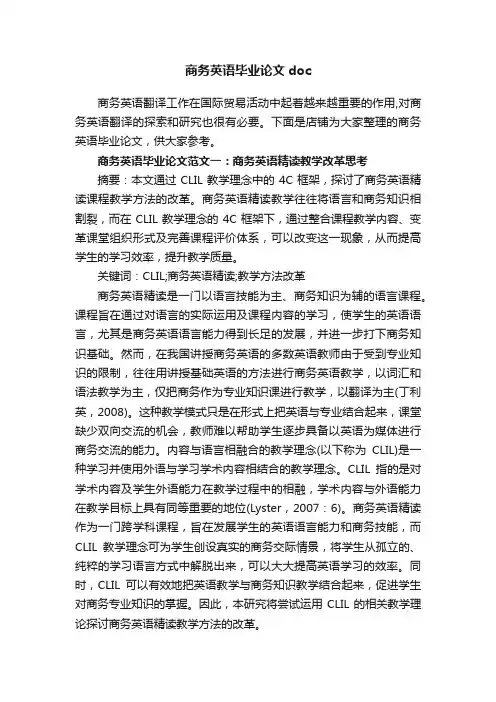
商务英语毕业论文doc商务英语翻译工作在国际贸易活动中起着越来越重要的作用,对商务英语翻译的探索和研究也很有必要。
下面是店铺为大家整理的商务英语毕业论文,供大家参考。
商务英语毕业论文范文一:商务英语精读教学改革思考摘要:本文通过CLIL教学理念中的4C框架,探讨了商务英语精读课程教学方法的改革。
商务英语精读教学往往将语言和商务知识相割裂,而在CLIL教学理念的4C框架下,通过整合课程教学内容、变革课堂组织形式及完善课程评价体系,可以改变这一现象,从而提高学生的学习效率,提升教学质量。
关键词:CLIL;商务英语精读;教学方法改革商务英语精读是一门以语言技能为主、商务知识为辅的语言课程。
课程旨在通过对语言的实际运用及课程内容的学习,使学生的英语语言,尤其是商务英语语言能力得到长足的发展,并进一步打下商务知识基础。
然而,在我国讲授商务英语的多数英语教师由于受到专业知识的限制,往往用讲授基础英语的方法进行商务英语教学,以词汇和语法教学为主,仅把商务作为专业知识课进行教学,以翻译为主(丁利英,2008)。
这种教学模式只是在形式上把英语与专业结合起来,课堂缺少双向交流的机会,教师难以帮助学生逐步具备以英语为媒体进行商务交流的能力。
内容与语言相融合的教学理念(以下称为CLIL)是一种学习并使用外语与学习学术内容相结合的教学理念。
CLIL指的是对学术内容及学生外语能力在教学过程中的相融,学术内容与外语能力在教学目标上具有同等重要的地位(Lyster,2007:6)。
商务英语精读作为一门跨学科课程,旨在发展学生的英语语言能力和商务技能,而CLIL教学理念可为学生创设真实的商务交际情景,将学生从孤立的、纯粹的学习语言方式中解脱出来,可以大大提高英语学习的效率。
同时,CLIL可以有效地把英语教学与商务知识教学结合起来,促进学生对商务专业知识的掌握。
因此,本研究将尝试运用CLIL的相关教学理论探讨商务英语精读教学方法的改革。
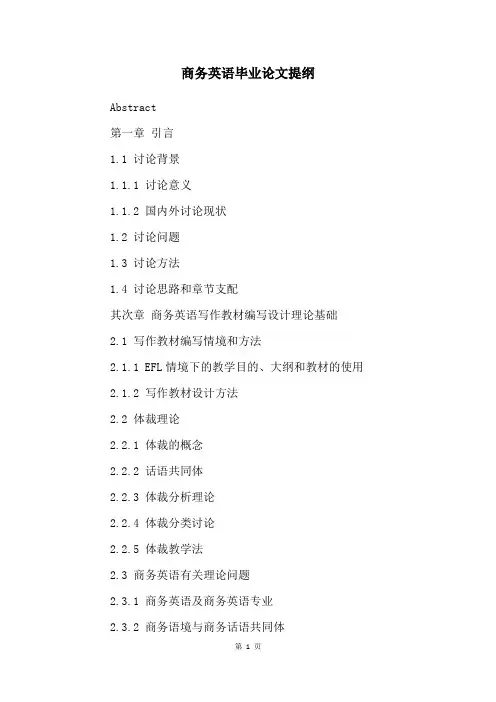
商务英语毕业论文提纲Abstract第一章引言1.1 讨论背景1.1.1 讨论意义1.1.2 国内外讨论现状1.2 讨论问题1.3 讨论方法1.4 讨论思路和章节支配其次章商务英语写作教材编写设计理论基础2.1 写作教材编写情境和方法2.1.1 EFL情境下的教学目的、大纲和教材的使用 2.1.2 写作教材设计方法2.2 体裁理论2.2.1 体裁的概念2.2.2 话语共同体2.2.3 体裁分析理论2.2.4 体裁分类讨论2.2.5 体裁教学法2.3 商务英语有关理论问题2.3.1 商务英语及商务英语专业2.3.2 商务语境与商务话语共同体2.3.3 商务英语写作教学理论2.3.4 商务英语体裁写作的内涵与特征小结第三章商务英语写作教材与商务英语写作现状调查分析 3.1 商务英语写作教材回顾3.2 商务英语写作教材调查3.2.1 国外主要商务英语写作教材状况3.2.2 国内主要商务英语写作教材状况3.2.3 国内商务英语写作教材编写特点3.2.4 国内商务英语写作教材编写存在的.问题3.3 国内商务英语写作教材使用状况调查3.3.1 问卷调查3.3.2 访谈调查3.3.3 调查结果分析3.4 国内商务英语写作状况调查3.4.1 调查对象及方法3.4.2 调查结果分析第四章体裁理论在商务英语写作教材编写中的应用4.1 现有商务英语写作教材的改良思路4.1.1 基于需求分析的教学大纲和教材编写4.1.2 建立专用语料库4.1.3 立体化教材编写4.1.4 将体裁理论应用于教材的设计和编写4.2 体裁理论下的商务英语写作教学设计4.2.1 基于体裁理论的商务英语写作教学过程4.2.2 基于体裁理论的CALL写作教学设计4.3 基于体裁理论的商务英语写作教材编写设计 4.3.1 以体裁概念为核心的编写模式4.3.2 体裁分析在商务英语写作教材编写中的应用 4.4 基于体裁理论的商务英语写作教材内容设计 4.4.1 基于学习者的商务英语写作体裁力量4.4.2 语言方面内容4.4.3 非语言方面内容4.4.4 商务写作教材中的体裁种类第五章结论5.1 本讨论的总结5.2 本论文的创新点5.3 缺乏之处和尚待讨论的问题。
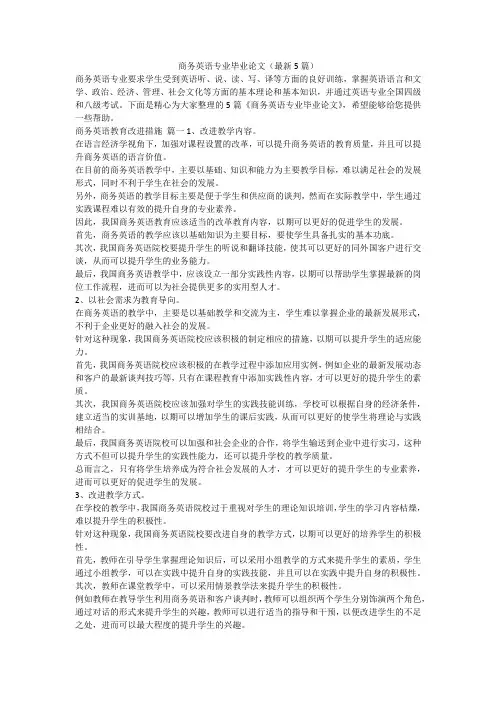
商务英语专业毕业论文(最新5篇)商务英语专业要求学生受到英语听、说、读、写、译等方面的良好训练,掌握英语语言和文学、政治、经济、管理、社会文化等方面的基本理论和基本知识,并通过英语专业全国四级和八级考试。
下面是精心为大家整理的5篇《商务英语专业毕业论文》,希望能够给您提供一些帮助。
商务英语教育改进措施篇一1、改进教学内容。
在语言经济学视角下,加强对课程设置的改革,可以提升商务英语的教育质量,并且可以提升商务英语的语言价值。
在目前的商务英语教学中,主要以基础、知识和能力为主要教学目标,难以满足社会的发展形式,同时不利于学生在社会的发展。
另外,商务英语的教学目标主要是便于学生和供应商的谈判,然而在实际教学中,学生通过实践课程难以有效的提升自身的专业素养。
因此,我国商务英语教育应该适当的改革教育内容,以期可以更好的促进学生的发展。
首先,商务英语的教学应该以基础知识为主要目标,要使学生具备扎实的基本功底。
其次,我国商务英语院校要提升学生的听说和翻译技能,使其可以更好的同外国客户进行交谈,从而可以提升学生的业务能力。
最后,我国商务英语教学中,应该设立一部分实践性内容,以期可以帮助学生掌握最新的岗位工作流程,进而可以为社会提供更多的实用型人才。
2、以社会需求为教育导向。
在商务英语的教学中,主要是以基础教学和交流为主,学生难以掌握企业的最新发展形式,不利于企业更好的融入社会的发展。
针对这种现象,我国商务英语院校应该积极的制定相应的措施,以期可以提升学生的适应能力。
首先,我国商务英语院校应该积极的在教学过程中添加应用实例,例如企业的最新发展动态和客户的最新谈判技巧等,只有在课程教育中添加实践性内容,才可以更好的提升学生的素质。
其次,我国商务英语院校应该加强对学生的实践技能训练,学校可以根据自身的经济条件,建立适当的实训基地,以期可以增加学生的课后实践,从而可以更好的使学生将理论与实践相结合。
最后,我国商务英语院校可以加强和社会企业的合作,将学生输送到企业中进行实习,这种方式不但可以提升学生的实践性能力,还可以提升学校的教学质量。
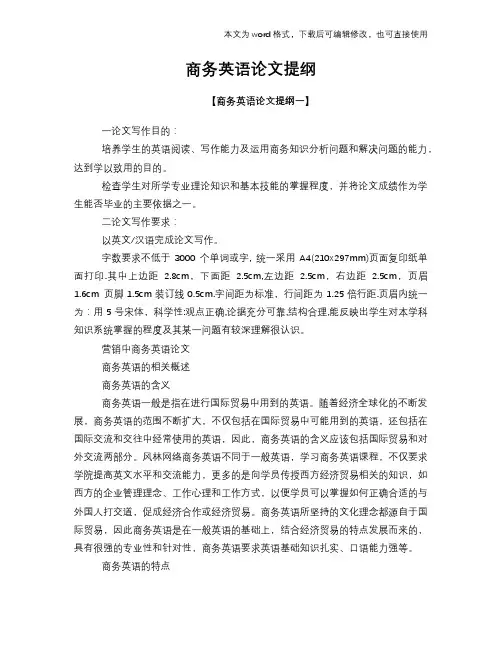
本文为word格式,下载后可编辑修改,也可直接使用
商务英语论文提纲
【商务英语论文提纲一】
一论文写作目的:
培养学生的英语阅读、写作能力及运用商务知识分析问题和解决问题的能力,达到学以致用的目的。
检查学生对所学专业理论知识和基本技能的掌握程度,并将论文成绩作为学生能否毕业的主要依据之一。
二论文写作要求:
以英文/汉语完成论文写作。
字数要求不低于3000个单词或字, 统一采用A4(210x297mm)页面复印纸单面打印.其中上边距2.8cm,下面距2.5cm,左边距2.5cm,右边距2.5cm,页眉1.6cm 页脚1.5cm装订线0.5cm.字间距为标准,行间距为1.25倍行距.页眉内统一为:用5号宋体,科学性:观点正确,论据充分可靠,结构合理,能反映出学生对本学科知识系统掌握的程度及其某一问题有较深理解很认识。
营销中商务英语论文
商务英语的相关概述
商务英语的含义
商务英语一般是指在进行国际贸易中用到的英语。
随着经济全球化的不断发展,商务英语的范围不断扩大,不仅包括在国际贸易中可能用到的英语,还包括在国际交流和交往中经常使用的英语,因此,商务英语的含义应该包括国际贸易和对外交流两部分。
风林网络商务英语不同于一般英语,学习商务英语课程,不仅要求学院提高英文水平和交流能力,更多的是向学员传授西方经济贸易相关的知识,如西方的企业管理理念、工作心理和工作方式,以便学员可以掌握如何正确合适的与外国人打交道,促成经济合作或经济贸易。
商务英语所坚持的文化理念都源自于国际贸易,因此商务英语是在一般英语的基础上,结合经济贸易的特点发展而来的,具有很强的专业性和针对性,商务英语要求英语基础知识扎实、口语能力强等。
商务英语的特点。
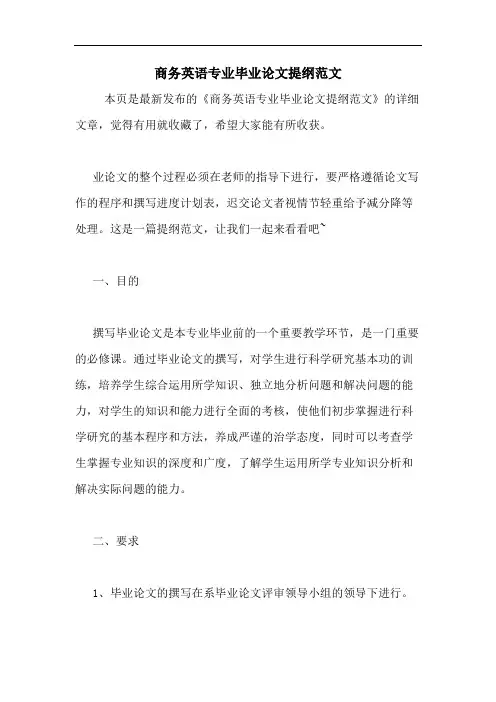
商务英语专业毕业论文提纲范文
本页是最新发布的《商务英语专业毕业论文提纲范文》的详细文章,觉得有用就收藏了,希望大家能有所收获。
业论文的整个过程必须在老师的指导下进行,要严格遵循论文写作的程序和撰写进度计划表,迟交论文者视情节轻重给予减分降等处理。
这是一篇提纲范文,让我们一起来看看吧~
一、目的
撰写毕业论文是本专业毕业前的一个重要教学环节,是一门重要的必修课。
通过毕业论文的撰写,对学生进行科学研究基本功的训练,培养学生综合运用所学知识、独立地分析问题和解决问题的能力,对学生的知识和能力进行全面的考核,使他们初步掌握进行科学研究的基本程序和方法,养成严谨的治学态度,同时可以考查学生掌握专业知识的深度和广度,了解学生运用所学专业知识分析和解决实际问题的能力。
二、要求
1、毕业论文的撰写在系毕业论文评审领导小组的领导下进行。
2、选题必须与本专业相关,涉及经贸、商务、经济等方面,内容要反映当前 ___实践,应尽量结合顶岗实习和毕业实习,论点对当前的经济、外贸、社会发展有一定的参考价值;可采取论文、研究或调查报告形式。
3、毕业论文撰写的整个过程必须在指导老师的指导下进行,要严格遵循论文写作的程序和撰写进度计划表,迟交论文者视情节轻重给予减分降等处理。
4、毕业论文格式要求,参见镇江高专外语系毕业论文写作规范。
5、毕业论文必须在导师指导下独立完成,发现抄袭剽窃或请人代作等情况一律以 ___论处。
模板,内容仅供参考。
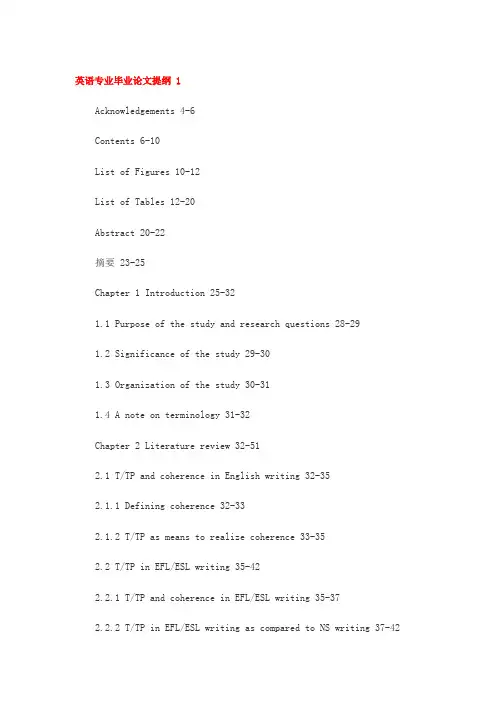
英语专业毕业论文提纲 1Acknowledgements 4-6Contents 6-10List of Figures 10-12List of Tables 12-20Abstract 20-22摘要 23-25Chapter 1 Introduction 25-321.1 Purpose of the study and research questions 28-291.2 Significance of the study 29-301.3 Organization of the study 30-311.4 A note on terminology 31-32Chapter 2 Literature review 32-512.1 T/TP and coherence in English writing 32-352.1.1 Defining coherence 32-332.1.2 T/TP as means to realize coherence 33-352.2 T/TP in EFL/ESL writing 35-422.2.1 T/TP and coherence in EFL/ESL writing 35-372.2.2 T/TP in EFL/ESL writing as compared to NS writing 37-422.3 T/TP in English research articles by EFL/ESL scholars 42-442.4 The factors that influence T/TP in EFL/ESL writing 44-472.5 Training in T/TP 47-492.6 Summary 49-51Chapter 3 Theoretical background 51-703.1 Systemic Functional Grammar 51-553.1.1 Five dimensions of language as a semiotic system 51-533.1.2 Three metafunctions of language as a functional system 53-543.1.3 Three lines of meaning from metafunctions 54-553.2 Theme and thematic progression 55-703.2.1 Theme 56-623.2.2 Thematic progression 62-70Chapter 4 Research Design 70-884.1 The participants and the educational context 70-734.1.1 Background of the participants and the participating school 704.1.2 The allocation of participants to the training 70-714.1.3 The sample sizes 71-724.1.4 The pilot study 72-734.2 The interventional procedures 73-744.3 The questionnaire 74-754.4 The training 75-804.4.1 Considerations behind the training 75-764.4.2 The training material 76-794.4.3 The role of the researcher as the trainer 79-804.5 Data analysis 80-864.5.1 Analysis of the writing 80-864.5.2 Analysis of the questionnaire 864.6 Ethical considerations 86-884.6.1 Informed consent 86-874.6.2 Anonymity 874.6.3 Harm 87-88Chapter 5 Results and analysis of pre-training writing 88-1155.1 Comparison of Themes in EEL pre-training writing and CEL pre-writing 88-1025.1.1 Topical,textual and interpersonal Themes 88-915.1.2 Topical Themes:marked and unmarked Themes 91-955.1.3 Textual Themes:continuatives,conjunctions and conjunctive adjuncts 95-1005.1.4 Interpersonal Themes 100-1025.2 Comparison of thematic progression in EEL pre-trainingwriting and CEL pre-writing 102-1105.2.1 Linear,constant,summative and split progressions 102-1075.2.2 Back,contextual and new Themes 107-1105.3 Summary 110-115Chapter 6 Results and analysis of post-training writing 115-1376.1 Comparison of Themes in EEL post-training writing and CEL post-writing 115-1296.1.1 Topical,textual and interpersonal Themes 115-1176.1.2 Topical Themes:marked and unmarked Themes 117-1216.1.3 Textual Themes:continuatives,conjunctions and conjunctive adjuncts 121-1266.1.4 Interpersonal Themes 126-1296.2 Comparison of thematic progression in EEL post-training writing and CEL post-writing 129-1326.2.1 Linear,constant,summative and split progressions 129-1316.2.2 Back,contextual and new Themes 131-1326.3 Summary 132-137Chapter 7 Results and analysis of pre- and post- training writing 137-1557.1 Comparison of Themes in pre- and post- training writing 137-1477.1.1 Topical,textual and interpersonal Themes 137-1397.1.2 Topical Themes:marked and unmarked Themes 139-1427.1.3 Textual Themes:continuatives,conjunctions and conjunctive adjuncts 142-1457.1.4 Interpersonal Themes 145-1477.2 Comparison of thematic progression in pre- and post- training writing 147-1507.2.1 Linear,constant,summative and split progressions 147-1497.2.2 Back,contextual and new Themes 149-1507.3 Summary 150-155Chapter 8 Results and analysis of the questionnaire 155-1658.1 Findings from closed questions 155-1608.1.1 EEL participants general attitude to training on T/TP 155-1578.1.2 EEL participants perception of the usefulness of the training on T/TP 157-1588.1.3 EEL participants perception of the learnability of T/TP158-1598.1.4 EEL participants perception of the applicability of T/TP in writing 159-1608.2 Findings from open questions 160-1648.2.1 The changes that occurred 161-1628.2.2 The perceived difficulty of applying the theory of T/TP in writing 162-1638.2.3 The reasons for the perceived difficulty in learning 1638.2.4 EEL participants suggestions for future training 163-1648.3 Summary 164-165Chapter 9 Discussion 165-1959.1 Findings with regard to research questions 165-1879.1.1 Chinese college students use of T/TP in pre-trainingwriting 165-1729.1.2 Chinese college students use of T/TP in post-training writing 172-1819.1.3 Effects of the training on T/TP in Chinese college students English writing 181-1879.2 Positioning the study within the literature 187-1909.2.1 T/TP in Chinese college students English writing 187-1899.2.2 Effects of training on Chinese college students use of T/TP 189-1909.3 Implications 190-1949.3.1 Pedagogical implication 190-1939.3.2 Methodological implication 193-1949.4 Limitations 194-195Chapter 10 Conclusion 195-20010.1 Summary 195-19710.2 Putting everything together 197-19910.3 Suggestions for future work 199-200Notes 200-202References 202-214Appendix 1: Plan for the interventional procedures 214-215 Appendix 2: The post-training questionnaire 215-217 Appendix 3: Training material 217-229Appendix 4: Teachers guide to the training 229-237 Appendix 5: Consent form for EEL group 237-238Appendix 6: Consent form for CEL group 238-239Appendix 7: Consent form for NS group 239英语专业毕业论文提纲 2中文摘要 3-4ABSTRACT 4Chapter One Introduction 7-101.1 Motivation of the present study 7-81.2 Significance of this study 81.3 Composition of this thesis 8-10Chapter Two Literature Review 10-192.1 Language production 10-142.1.1 L1 Production 10-112.1.2 L2 Production 11-122.1.3 Dimensions of language production 12-142.2 Theories on oral output 14-152.2.1 Skehans dual-model system 142.2.2 Swains Output Hypothesis 14-152.3 Task Repetition 15-172.3.1 Task 15-162.3.2 Task repetition 16-172.4 Relevant studies on effects of task repetition on L2 oral output 17-19CHARPTER THREE THE CURRENT STUDY 19-253.1 Research justification and questions 193.2 Hypothesis 19-203.3 Methods 20-253.3.1 Participants 20-213.3.2 Material 213.3.3 Research design 21-233.3.4 Measures 23-25Chapter Four Results and Discussion 25-414.1 Results and Analysis 25-344.1.1 Quantitative analysis 25-274.1.2 Qualitative analysis 27-344.2 Discussion 34-414.2.1 Fluency 34-364.2.2 Complexity 36-384.2.3 Accuracy 38-394.2.4 interlanguage development path of learner L 39-41 Chapter Five Conclusions 41-445.1 Conclusion and implication 41-435.2 Limitations and recommendations 43-44 Acknowledgements 44-45References 45-49Appendixes 49-54A. Instructions of the experiment 49-50B. The same-content task 50-51C. The different-content task 51-52D. Sample of oral pre-task 52-53E. Sample of oral post-task 53-54F. Sample of writing repetition task 54。
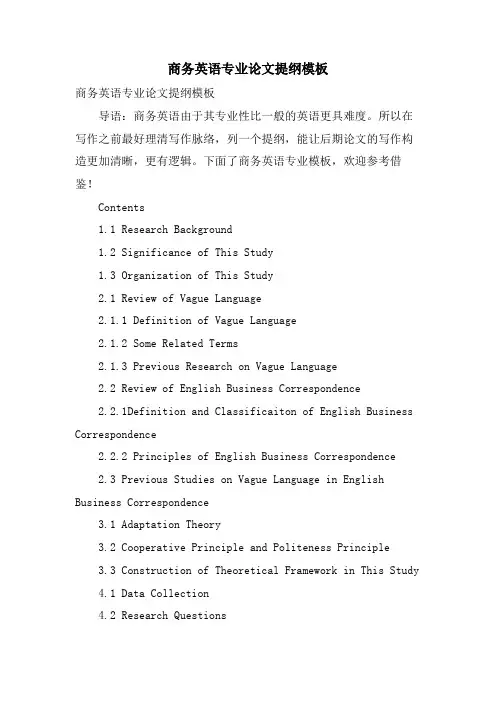
商务英语专业论文提纲模板商务英语专业论文提纲模板导语:商务英语由于其专业性比一般的英语更具难度。
所以在写作之前最好理清写作脉络,列一个提纲,能让后期论文的写作构造更加清晰,更有逻辑。
下面了商务英语专业模板,欢迎参考借鉴!Contents1.1 Research Background1.2 Significance of This Study1.3 Organization of This Study2.1 Review of Vague Language2.1.1 Definition of Vague Language2.1.2 Some Related Terms2.1.3 Previous Research on Vague Language2.2 Review of English Business Correspondence2.2.1Definition and Classificaiton of English Business Correspondence2.2.2 Principles of English Business Correspondence2.3 Previous Studies on Vague Language in English Business Correspondence3.1 Adaptation Theory3.2 Cooperative Principle and Politeness Principle3.3 Construction of Theoretical Framework in This Study4.1 Data Collection4.2 Research Questions4.3 Analytical Methods5.1 Realization Forms and Frequency of Vague Language5.1.1 Distribution of Vagueness in Content and Mood5.1.2 Linguistic and Pragmatic Realization Forms and Frequency of Vague Lanaguage5.2 Situations to Use Vague Language in English Business Correspondence5.2.1 Unable to Get Sufficient Information5.2.2 Unwilling to Give Certain Information5.3 Pragmatic Interpretation of Vague Language in English Business Correspondence5.3.1 Interpretation of Vague Language Based on Adaptation Theory5.3.1.1 Adaptation to Physical World5.3.1.2 Adaptation to Social World5.3.1.3 Adaptation to Mental World5.3.2 Interpretation of Vague Language Based on Cooperative Principle and Politeness Principle5.3.2.1 Violating Cooperative Principle5.3.2.2 Abiding by Politeness Principle5.4 Pragmatic Functions of Vague Language in English Business Correspondence5.4.1 Making Language More Persuasive5.4.2 Making Correspondence More Polite5.4.3 Increasing Self-protection6.1 Major Findings6.2 Limitations6.3 Suggestions for Future Study References AppendixAcknowledgements。
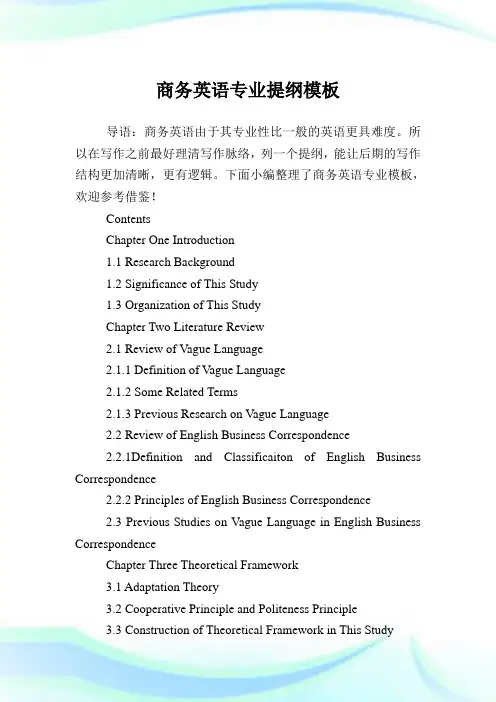
商务英语专业提纲模板导语:商务英语由于其专业性比一般的英语更具难度。
所以在写作之前最好理清写作脉络,列一个提纲,能让后期的写作结构更加清晰,更有逻辑。
下面小编整理了商务英语专业模板,欢迎参考借鉴!ContentsChapter One Introduction1.1 Research Background1.2 Significance of This Study1.3 Organization of This StudyChapter Two Literature Review2.1 Review of Vague Language2.1.1 Definition of Vague Language2.1.2 Some Related Terms2.1.3 Previous Research on Vague Language2.2 Review of English Business Correspondence2.2.1Definition and Classificaiton of English Business Correspondence2.2.2 Principles of English Business Correspondence2.3 Previous Studies on Vague Language in English Business CorrespondenceChapter Three Theoretical Framework3.1 Adaptation Theory3.2 Cooperative Principle and Politeness Principle3.3 Construction of Theoretical Framework in This StudyChapter Four Methodology4.1 Data Collection4.2 Research Questions4.3 Analytical MethodsChapter Five Pragmatic Analysis of Vague Language in English Business Correspondence5.1 Realization Forms and Frequency of Vague Language5.1.1 Distribution of Vagueness in Content and Mood5.1.2 Linguistic and Pragmatic Realization Forms and Frequency of Vague Lanaguage5.2 Situations to Use Vague Language in English Business Correspondence5.2.1 Unable to Get Sufficient Information5.2.2 Unwilling to Give Certain Information5.3 Pragmatic Interpretation of Vague Language in English Business Correspondence5.3.1 Interpretation of Vague Language Based on Adaptation Theory5.3.1.1 Adaptation to Physical World5.3.1.2 Adaptation to Social World5.3.1.3 Adaptation to Mental World5.3.2 Interpretation of Vague Language Based on Cooperative Principle and Politeness Principle5.3.2.1 Violating Cooperative Principle5.3.2.2 Abiding by Politeness Principle5.4 Pragmatic Functions of Vague Language in EnglishBusiness Correspondence5.4.1 Making Language More Persuasive5.4.2 Making Correspondence More Polite5.4.3 Increasing Self-protectionChapter Six Conclusion6.1 Major Findings6.2 Limitations6.3 Suggestions for Future Study ReferencesAppendixAcknowledgements。
商务英语专业毕业论文指导书第一篇:商务英语专业毕业论文指导书一、论文写作目的:商务英语专业学生撰写毕业论文的主要目的是:1、学生的英语阅读、写作能力及运用商务知识分析问题和解决问题的能力,达到学以致用的目的。
2、检查学生对所学专业理论知识和基本技能的掌握程度,并将论文成绩作为学生能否毕业的主要依据之一。
3、学生根据选定的题目,搜集相关资料,进行分析和说明, 具体问题的感性认识,同时培养学生理论联系实际,增强独立思考问题和解决问题的能力。
二、论文写作要求:1、以英文/汉语完成论文写作。
2、字数要求3000~~4000个单词(B5纸10页左右); 汉语不少于4000字, 字号正文5号,论文大标题小2号,正文小标题字号小4,粗体,行距1.5,汉语论文文字用宋体。
3、论文格式按《广东科学技术职业学院毕业论文》参见附录。
4、论文的内容要与本专业所要求的知识和技能相结合,要求论述者阅读一定量的英文资料,能够对所有的资料进行合理删减、组织和编辑,掌握论文撰写的结构与布局。
要求语言流畅,层次清晰,论点明确,论据充分。
5、写作时间为6周(从2月中旬开始,3月31日交稿)三、论文选题方向:1、商务英语,贸易活动英语等特殊用途英语;2、英美文学欣赏与比较;3、名著评论赏析;4、英文翻译技巧;5、词语不同用法比较;6.对珠海或泛珠三角区域旅游现状进行分析或提出对策;★参考选题见附件四、论文设计与拟定的程序:1、指导教师的帮助下,根据本指导书提供的选题范围,从中选择论文方向,确定题目。
(注:选择其他的题目,需与指导教师商议确定)2、搜寻与本人论文题目相关的资料,文献,形成论文大纲,注意论文结构安排的合理性。
3、根据论文大纲及所掌握的资料,整理充实论文,与指导教师主动联系,征求指导教师意见。
4、对于优秀论文学生可申请论文答案辩。
论文答辩程序如下:(1)规定时间,顺序参加答辩;(2)每位答辩人答辩时间均为30分钟;其中陈述论文要点10-15分钟;答辩教师团提问5-10分钟,答辩人回答问题10分钟;(3)答辩教师团共同讲座论文答辩的成绩。
商务英语论文写作教学大纲商务英语论文写作教学大纲一、引言商务英语论文写作是商务英语专业学生必备的一项重要技能。
随着全球化进程的加速,商务交流的需求也日益增长。
因此,培养学生在商务领域进行有效沟通和写作的能力显得尤为重要。
本教学大纲旨在帮助学生掌握商务英语论文写作的基本技巧和方法,以提高他们的写作水平和学术能力。
二、写作目标1. 培养学生的写作能力,使其能够撰写符合学术规范的商务英语论文;2. 培养学生的独立思考和分析问题的能力;3. 培养学生的信息搜索和整理能力;4. 培养学生的团队合作和沟通能力。
三、教学内容1. 论文结构和格式a. 引言:介绍研究背景、目的和意义;b. 文献综述:对相关研究进行梳理和总结;c. 研究方法:介绍研究方法和数据分析方法;d. 结果与讨论:呈现研究结果并进行深入讨论;e. 结论:总结研究成果并提出对未来研究的展望;f. 参考文献:列出引用的文献。
2. 论文写作技巧a. 清晰明确的表达:使用简洁准确的语言,避免冗长和模糊的表达;b. 逻辑严谨的结构:按照论文结构合理组织内容,确保论文的逻辑连贯性;c. 恰当引用文献:引用相关文献并正确标注,避免抄袭和侵权;d. 数据分析和图表设计:使用合适的数据分析方法和图表,清晰地呈现研究结果;e. 语法和拼写检查:注意语法错误和拼写错误,保证论文的语言准确性。
四、教学方法1. 课堂讲授:通过讲解理论知识和实例分析,介绍论文写作的基本要求和技巧;2. 小组讨论:组织学生进行小组讨论,共同解决论文写作中的难题和疑惑;3. 个人指导:为学生提供个别指导,帮助他们解决个人写作问题;4. 实践训练:组织学生进行实践训练,撰写商务英语论文,并进行互评和改进。
五、教学评价1. 期中考试:考察学生对论文结构和格式的掌握程度;2. 作业评估:评估学生的论文写作能力和学术素养;3. 小组讨论评价:评估学生在小组讨论中的表现和合作能力;4. 论文评审:对学生撰写的商务英语论文进行评审和指导。
《商务英语写作》8-10单元提纲_9048(精选五篇)第一篇:《商务英语写作》8-10单元提纲_9048Business Writing Review outlineUnit Eight1.The definition of a business proposalp.205A business proposal is an offer or bid to do a certain project for someone or for some other company.More specifically, a proposal is a plan for solving a problem either for your company or for your client’s corporation and agency.2.Types of Business Proposalp.205-206⊙Internal vs.External⊙Solici ted vs.Unsolicited⊙Large vs.Small3.Match your business & objectives with clientsp.206Approach your proposal as a problem-solving activityRegard your readers as skepticalResearch your proposal thoroughlyScout out your competitorsProve that your proposal is workableBe sure your proposal is financially realisticPackage your proposal attractively4.Writing elements of a business proposalp.208Problems/ solutions/ benefits/ credibility/ samples/ targeted/ personalization5.Channels of Proposalp.209-210⊙ Oral presentation⊙ Memo & E-mail proposals⊙ Letter proposal⊙ Business/ Technical-report proposals6.Simple Form for Proposal Writingp.211-213⊙External ProposalA.IntroductionB.Problem identified and definedC.Objective & goal setD.Solutions proposedE.Implementation & measuringF.Costs and timeframe estimated⊙Internal ProposalA.Identify the problemB.Define the problemC.Generate solutionspare costs with benefits7.Basic Components of a RTPP.224⊙Description of the project⊙Clearly stated ne eds or requirements⊙Budget⊙Time frame⊙Who has “ownership” of the project?⊙Potential risksUnit Nine1.The definition of a business reportp.231A written report is a document that conveys information to a reader who will use the information to make a decision.Most reports are written because readers want and expect them.2.Types of reportsp.231-232Reports are typically classified according to their purposes in the organization.⊙Routine Reports⊙Task Reports3.Report Qualitiesp.233Accurate, Reliable, Objective4.Special Parts in Business Reportp.239-240·Title page: It contains four main elements——the title, the “prepared for” line, the “prepared by” line, and the date.COST ANALYSIS OF PRODUCT F AND ESUBMITTED TO……PREPARED BY……OCTOBER 20, 2010·Letter of Authorization·Letter of Transmittal·Table of Contents——shows the headings in a report and their page numbers.·Table of Illustrations——list of figures ·Abstract——a brief overview of the entire report·Executive Summary——summarizes essential elements in a report·Body·Appendices·Bibliography·Index5.Ways of gathering informationp.242-243⊙Secondary Sources⊙Primary Sourcesmon Business Reportsp.250Memo ReportsLetter ReportsAgenda, MinutesExpense ReportsPersonnel EvaluationsProgress ReportsRecommendation ReportsProposalsFeasibilityFormal ReportsUnit Ten1.The definition of contract.P.262A contract is a voluntary undertaking between or among people and organizations that creates a relationship in which one or more of the parties to the contract promise to do something, or not do something.2.The definition of some special termsp.263A promise is a manifestation of intent to act or refrain from acting in a specified way.Breach or default of contract is a failure to fulfill a promise.A remedy is the solution or amelioration of a problem or difficulty.3.Validity of contractsp.263-264 ·A valid contract must meet the following criteria.·Offer·Acceptance·Mutual consent or meeting of the minds·Cons ideration·Capacity·Legality·Proper form·Mutual right to remedy·Mutual obligation to perform1.Some contract-related termsBargain——An agreement between parties fixing obligations that each promises to carry out.Agreement——The act of agreeing.Void, voidable and unenforceable contractsp.266 Conclusion:Key Points:Definition of some important termsWriting: MemoMinutesGeneral writing(inquiry letter, letter of establishing business relationship with another company…..)第二篇:商务英语写作向进军2011级B班20112513486Dear sir ,Thank you very much for your interest in our products.You wrote to the right kitchen range hood manufacturer.Ours is one of the largest company in the northwest of China.The company has taken a five-year-long quality guarantee , longer than that of most other manufacturers.With a long history and high reliability , this company has established a good reputation at home and abroad.Our products are always very popular in Europe and China.With your help ,we are hoping to penetrate the huge market in America.We have enclosed a catalogue of all the specifications and varieties of our products.We are awaiting the opportunity of cooperating with you.Yours faithfully ,JocelynSales manager第三篇:商务英语写作Dear Sirs,This is to introduce ourselves as the largest down Apparel Company in China.Our company--Bosideng International Holdings Limited—was established in 1976, locating in Bosideng industrial zone, Changshu City, Jiangsu province.We have been specialized in developing and producing all kinds of down apparel.Bosideng International Holdings Limited has been researching and producing many kinds of down apparel for 30 years.There are six brands of the our company including “Bosideng”, “Snow Flying”, “Combo”, “Bengen”, “Slim” and “shangyu”.Through these brands, we offer a wide range of down apparel products.The customer canorder our products both in our website and through the phone, and then ,we would like to give them satisifying in one week.“Bosideng” was the leading down apparel brand in China for 17 consecutive years from 1995 to 2011.As a leader in China down apparel industry, for 16 consecutive years, the latest fashionable FallWinter apparel trends to the world on behalf of China at the “China International Clothing and Accessories Fair”We would be pleased to receive your any kinds of down apparel.If you have any questions, please contact us.Our telephone number is 86-512-52532888.We look forward to your positive reply.Very truly yours.18100619 陆浩杰18100634蔡耀第四篇:商务英语写作A: You must be Ms.Lee from the United States?B: That’s right.I’ m Lee Junru.You are...?A: My name is Zhang Guiyang.I’m from the Sunshine Corporation.I’m pleased to meet you.Welcome to Fuzhou.B: Nice to meet you, too.Thanks for coming to the airport to meet me.A: That’s my pleasure.My manager, Mr.Wang has sent me to meet you here.He felt sorry he could’t come himself.He is at a meet right now.B: It’s OK.Thank you very much.Where are we heading now?A: We’ re going to accompany you to the Fuzhou Friendship Hotel.Is the luggage all here, Ms.Lee? The car is just out there in the parking lot.B: Oh, thank you.Well I can handle this handbag myself.A: OK, this way, please.A: Here is our car.Let me put the luggage into the trunk.B: Thanks.A: Please get on, Ms.Lee.B: Thanks.A: Off we go.How’s your fligh t, Ms.Lee?B: Fine, I got on the plane at New York, and it took about 1 hours to get here.But is was a smooth flight.A: That was really kind of long in the airplane.Wasn’t it? I hope you’ll feel restedafter a right of good sleep.B: Thank you.What is the weather like here, today?A: Fair and sunny today with gentle breeze.As I know, Ms.Lee, you’ re been to Fuzhou for a couple of times.B: It’s true.I travel so much and visit Fuzhou once a year?A:How do you like it here.B:well, I like it a lot.Fuzhou is really a fantastics place.There are many interested places to visit.I hope I can visit once again.A:I hope you can enjoy your stay here.It’s nice to have a look around.B:Yes that must be very interesting.Hope we will have the time.A:I think you must be tired, why don’t you take a break.I wake you up in to the hotel.B:Than’s great.Thank you.第五篇:商务英语写作[模版]七种常见类型1.主动跟新买家建立联系Dear Mr.Jones:We understand from your information posted on that you are in the market for textiles.We would like to take this opportunity to introduce our company and products, with the hope that we may work with Bright Ideas Imports in the future.We are a joint venture specializing in the manufacture and export of textiles.We have enclosed our catalog, which introduces our company in detail and covers the main products we supply at present.You may also visit our online company introduction atwhich includes our latest product line.Should any of these items be of interest to you, please let us know.We will be happy to give you a quotation upon receipt of your detailed requirements.We look forward to receiving your enquires soon.Sincerely,John Roberts2.对新买家要求建立业务联系的回复Dear Mr.Jones:Dear Mr.Jones:take the matter further.We would be very happy to send samples to you for close inspection.We will keep you informed on our progress and look forward to hearing from you.Sincerely,4.回复对某个产品的查询Dear Mr.Jones:Thank you for your inquiry of 16 March.We are pleased to hear that you are interested in our product “toaster”.We've enclosed the photo and detailed information of the product for your reference:Product: toasterSpecification: xxxxxxxxxxxxxxxPackage: 1pcs/boxPrice: 10usd/pcsPayment: L/CFor purchase quantities over 1,000pcs of individual items we would allow you a discount of 1%.Payment is to be made by irrevocable L/C at sight.We look forward to receiving your first order.Sincerely,5.无法提供对方查询中所要求的产品时Dear Mr.Jones:Dear Sir or Madam:We know that you are exporter of textile fabrics.We would like you to send us details of your various ranges, including colors and prices, and also samples of the different qualities of material used.We are volume dealers in textiles and believe there is a promising market in our area for moderately priced goods of this kind mentioned.When quoting, please state your terms of payment and discount you would allow on purchases of quantities of not less than 1000 meters of individual items.Pricesquoted should include insurance and freight to San Francisco.Sincerely,7.几种报盘(a.)Dear Mr.Jones:We thank you for your email enquiry for both groundnuts and Walnutmeat CNF Copenhagen dated February, 21.In reply, we offer firm, subject to your reply reaching us on or before February 26 for 250 metric tons of groundnuts, handpicked, shelled and ungraded at RMB2000 net per metric ton CNF Copenhagen and any other European Main Ports.Shipment is to be made within two months after receipt of your order payment by L/C payable by sight draft.Please note that we have quoted our most favorable price and are unable to entertain any counter offer.You may be aware that there has lately been a large demand for the above commodities.And such growing demand will likely result in increased prices.However you can secure these prices if you send us animmediate reply.Sincerely,(b.)Dear Mr.Jones:We thank you for your letter dated April 8 inquiring about our leather handbags.As requested, we take pleasure in offering you, subject to our final confirmation, 300 dozen deerskin handbags style No.MS190 at $124.00 per dozen CIF Hamburg.Shipment will be effected within 20 days after receipt of the relevant L/C issued by your first class bank in our favor upon signing Sales Contract.We are manufacturing various kinds of leather purses and waist belts forexportation, and enclosed a brochure of products for your reference.We hope some of them meet your taste and needs.If we can be of any further help, please feel free to let us know.Customers’ inquiries are always meet with our carefulattention.Sincerely,(c.)Re: SWC SugarDear Sirs,We are in receipt of your letter of July 17, 2002 asking us to offer 10,000 metric tons of the subject sugar for shipment to Japan and appreciate very much your interest in our product.To comply with your request, we are offering you the following:modity: Qingdao Superior White Crystal Sugar.2.Packing: To be packed in new gunny bag of 100kgs.each.3.Quantity: Ten thousand(10000)metric tons.4.Price: US dollars one hundred and five(US$105.00)per metric ton, Fob Qingdao.5.Payment: 100% by irrevocable and confirmed letter of credit to be opened in our favor through A1 bank in Qingdao and to be drawn at sight.6.Shipment: Three or four weeks after receipt of letter of credit by the first available boat sailing to Yokohama direct.Please note that we do not have much ready stock on hand.Therefore, it is important that, in order to enable us to effect early shipment, your letter of credit should be opened in time if our price meets with your approval.We are awaiting your reply.Sincerely,。
商务英语提纲写作一、写作目的:是商务英语专业教学计划的最后一个环节,也是对学生2年半学期各门课程学习效果的检查.其主要目的是:1、培养学生的英语阅读、写作能力及运用商务知识分析问题和解决问题的能力,达到学以致用的目的。
2、检查学生对所学专业理论知识和基本技能的掌握程度,并将成绩作为学生能否毕业的主要依据之一。
3、训练学生搜集运用资料的技能,同时培养学生理论联系实际,增强独立思考问题和解决问题的能力。
二、写作要求:1、以英文/汉语完成写作。
2、字数要求不低于3000个单词或字, 统一采用A4(210x297mm)页面复印纸单面打印.其中上边距2.8cm,下面距2.5cm,左边距2.5cm,右边距2.5cm,页眉1.6cm页脚1.5cm装订线0.5cm.字间距为标准,行间距为1.25倍行距.页眉内统一为:用5号宋体3、的内容要与本专业所要求的知识和技能相结合,要求论述者阅读一定量的英文和中文资料,能够对所有的资料进行合理删减、组织和编辑,掌握撰写的结构与布局。
要求语言流畅,层次清晰,论点明确,论据充分。
具有以下特性:1) 科学性:观点正确,论据充分可靠,结构合理,能反映出学生对本学科知识系统掌握的程度及其某一问题有较深理解很认识营销中商务英语1、商务英语的相关概述1.1商务英语的含义商务英语一般是指在进行国际贸易中用到的英语。
随着经济全球化的不断发展,商务英语的范围不断扩大,不仅包括在国际贸易中可能用到的英语,还包括在国际交流和交往中经常使用的英语,因此,商务英语的含义应该包括国际贸易和对外交流两部分。
商务英语不同于一般英语,学习商务英语课程,不仅要求学院提高英文水平和交流能力,更多的是向学员传授西方经济贸易相关的知识,如西方的企业管理理念、工作心理和工作方式,以便学员可以掌握如何正确合适的与外国人打交道,促成经济合作或经济贸易。
商务英语所坚持的文化理念都源自于国际贸易,因此商务英语是在一般英语的基础上,结合经济贸易的特点发展而来的,具有很强的专业性和针对性,商务英语要求英语基础知识扎实、口语能力强等。
英语论文提纲样本一、选题依据及意义(不少于300字).二、研究目标与主要内容(含论文(设计)提纲,不少于500字).1.研究目标:2.主要内容(提纲):1. Introduction2. The present situation of English writing in senior high schools3. The nature of reading and writing3.1 The nature of reading3.2 The nature of writing4. The relationship between reading and writing4.1 Reading paves the way for writing4.2 Writing promotes reading5. The necessity and feasibility of reading-to-writing5.1 The necessity of reading-to-writing5.2 The feasibility of reading-to-writing6. The advantages of applying reading-to-writing approach6.1 The definition of reading-to-writing approach7. The application of reading-to-writing approach7.1 The principles of applying reading-to-writing approach7.1.1 Paying equal attention to reading and writing7.1.2 Paying equal attention to intensive reading and extensive reading 7.2 The selection of good reading materials7.3 Ways of adapting reading-to-writing approach7.3.1 Pre-writing reading7.3.2 Writing from reading7.3.3 Post -writing reading and rewriting不想长大三、研究方法和手段。
商务英语论文提纲商务英语论文提纲商务英语论文提纲篇1浅谈商务英语在对外贸易中的作用摘要中国是世界经济发展动力源,也是WTO重要成员国,生产与营销的各方面都与世界接轨。
随着我国与各国经济贸易合作日趋频繁,商务英语在对外贸易中的运用也随之增多,其重要性也日益凸显。
我们可以通过商务英语获取商业新知,进行促销,还可以通过商务英语开展其它有效的工作。
本文通过分析商务英语的内涵和特点,探讨了商务英语在对外贸易中的重要作用。
关键词:商务英语;对外贸易;作用目录一、前言二、商务英语的概念(1) 商务英语的内涵(2) 商务英语的特点三、商务英语在对外贸易中的作用(1) 商务英语在对外贸易中的地位(2) 商务英语在对外贸易中传递新知识(3) 商务英语是对外贸易沟通的桥梁四、商务英语与国际营销(1) 商务英语是从事国际营销的基础(2) 商务英语在国际营销中的专门用途(3) 商务英语在国际营销中起到的作用五、结束语商务英语论文提纲篇2一、撰写毕业论文的目的进一步提高学生的英语阅读、翻译、写作能力,文字表达能力,信息搜集与分析处理能力,独立思考问题并能理论联系实际,运用商务知识分析问题和解决问题的能力。
检查学生对所学专业理论知识和基本技能的掌握程度,并将论文成绩作为学生能否毕业的主要依据之一。
二、撰写毕业论文的步骤(一)准备阶段1、明确指导教师。
根据基础部毕业论文指导工作小组的安排,每个学生明确自己的指导教师,建立联系方式。
2、确定选题方向。
选题应结合商务英语专业培养目标,体现英文词语用法比较、英文翻译或写作技巧、英文函电制作、英语谈判策略与技巧、英语在商贸活动中的特殊用法等方向。
学生可根据自身能力、兴趣或实习工作实际确定选题,也可由指导教师指定,要求一人一题。
选题必须征求指导教师的意见,得到指导教师的确认。
3、撰写开题报告。
学生根据选题在指导教师指导下完成开题报告。
开题报告格式与内容应包括:学生姓名、专业、班级、学号、课题名称、指导教师姓名、职称与学位、课题类别、课题的`内容与要求、前言(课题研究的目的与意义、课题的国内外研究现状与趋势、课题欲解决的问题)、课题研究方案的比较与评价(课题研究的思路、角度与方法)、课题研究的预期效果及指标、作者工作安排(包括选题、调研、收集资料、论证、开题、撰写初稿、修改、定稿的打印等各个阶段)、参考文献以及指导教师意见等(详见《扬州工业职业技术学院毕业论文开题报告书》)。
Implication of Cultural Differences on
International Business Negotiations
Abstract
Culture is a national system of specific concepts and values. These concepts become people’s behavior during their life and work. The impacts of regional differences, ethnic differences, political differences, economic differences, religious differences and value differences on people’s life are embodied in the catering, clothing, housing, holidays, rituals and other material and cultural life in all aspects. These result in cultural differences in different countries and regions.
Key words: culture; differences; business negotiation; implication
Outline
I. Cultural differences
1.1 The definition of culture
1.2 The causes of cultural differences
1.2.1 geographical differences
1.2.2 Ethnic Differences
1.2.3 political differences
1.2.4 economic disparities
1.2.5 religious differences
1.2.6 the concept of V alues difference
1.2.7 Law and Ethics Differences
II. Cultural differences on the impact of international business negotiations
2.1 communication process
2.2 Impact of Value Views Differences on International Business Negotiations 2.2.1 Impact of Time View Difference on Negotiation.
2.2.2 Impact of Equality View Difference on Negotiation
2.2.3 Impact of Objectivity Difference on Negotiation
2.2.4 Impact of Thinking Model Differences on International Business Negotiation 2.2.5 Ethics
2.2.6 The concept of collective
2.3 Negotiating Style Differences
2.4 International Thinking and Analytic Thinking
2.5 Negotiation Structure
2.6 Negotiation Style
III. Conclusion
文化因素对国际商务谈判的影响
摘要:
文化是国家系统特有的思想和价值。
在人们的生活和工作中,这些思想与他们的行为相对应。
地区差异、种族差异、政治差异、经济差异、宗教差异和价值观差异的影响,都表现在饮食,衣着,住,假期,宗教礼仪和其他物质与文化生活中的各个方面,这些都导致在不同国家和地区的文化差异。
关键词:文化,文化差异,商务谈判,影响
提纲:
文化因素对国际商务谈判的影响
一、文化差异
1、文化的定义
2、产生文化差异的原因
(1)地理上的差异
(2)民族、种族的差异
(3)政治意见的差异
(4)经济条件差异
(5)宗教信仰的差异
(6)价值观的差异
(7)道德和法律的差异
二、文化差异对国际商务谈判的影响
1、通信谈判的语言
2、文化价值
(1)时间观念差异对国际商务谈判的影响
(2)平等观念差异对国际商务谈判的影响(3)客观性差异对国际商务谈判的影响(4)思维模式差异对国际商务谈判的影响(5)道德
(6)集体的概念
3、谈判风格的差异
4、分析性思维
5、谈判结构
6、谈判风格
三、结论。